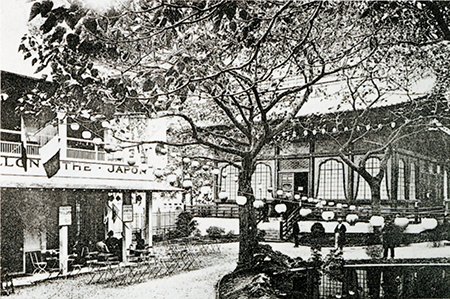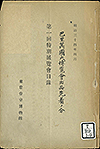pdf:17.3MB
▲ Department of Art Research, Archives and Information Systems
▲ Home
▲ Dept.English TOP
Exhibition catalogue of the 1st and 2nd special exhibition (combined) Tokyo Imperial Museum, List of the works of the Exhibition of Japanese Art held at the Paris World Exposition in 1900
As the inscription on the cover and the description the first page indicate, this document is the list of the works on view at the exhibition of the traditional Japanese art held at the Paris World Exposition in 1900, which was divided two groups and exhibited also in Japan after their return from Paris. Official Report of the Special Exposition published by the Ministry of Agriculture and Commerce in 1902(pp831-881) gives information about the exhibition of Japanese traditional art at the Paris World Exposition in 1900. It tells that Prince Arisugawa, who visited Paris on his way back from his participation to the celebration of Great Britain’s Imperial coronation 60 years, was requested to send Japanese traditional art works to the Paris World Exposition in 1900 by the Minister of Foreign Affairs in France. Discussion was made in Japan and decision was made to build a hall to exhibit the masterful works of art to show Japanese art history (Official Report of the Special Exposition published by the Ministry of Agriculture and Commerce in 1902, p836). Society of Japanese art or Nihon Bijutsu Kyokai helped to make selection of the works and President of the Exposition, SONE Arasuke and officers of the Expo worked very hard to negotiate with the owners of the works. As the list shows, 381 items were gathered from private collectors and famous temples and shrines. While some were afraid of shipping these fine works of art to overseas, these works were divided into 85 packages and HAYASHI Tadamasa, executive director of the Japanese office of the Paris World Exposition in 1900, brought seven packages including ones with Imperial collection to Paris by himself. Other packages were divided into three groups and shipped with officers of the Japanese office of the Paris World Exposition who played a role as couriers.

Japanese Tea House (left) and Exhibition Hall of Japanese traditional art (right) in Trockadero
(from Official Report of the Special Exposition, the Ministry of Agriculture and Commerce, 1902)
To exhibit the works, a hall having plan of the Golden Hall of Horyuji temple was built at Trockadero where Japanese pavilions were built at the Paris World Exposition. The materials of the building were gathered in France. It was 24 meter wide and 18 meter long, which had compartment ceiling with patterns of dragons, phoenix and flowers and floor all covered with painted tiles. The installation was changed several times during the period of Expo since 5h May to 31th October. Audience were limited to those who wanted to see it and had tickets while French senate, professors and students of the National Academy of fine arts were given special tickets to make them free to see the exhibition.
Official Report of the Special Exposition published by the Ministry of Agriculture and Commerce in 1902 reports “it was such a special project gathering so many works of Japanese traditional art at one place, and shipping them overseas was out of expectation. We believe this exhibition publicized the truth of Japanese art and played very big role to make people overseas not only respect Japanese art more but also recognize how deep and old the origin of our culture”(Official Report of the Special Exposition published by the Ministry of Agriculture and Commerce in 1902, p879).
As description of this catalogue tells, it was very precious opportunity to have so many masterpieces at one place, works were exhibited in Japan after returning from Paris. The exhibition was held at the Tokyo Imperial Museum (today, Tokyo National Museum), and the 1rst one was held between 15th April to 5th May, and the 2nd one was between 21th May and 10th June in 1901.
Although citing the works from this catalogue is difficult since it lacks the illustrations, there are many items one can presume such as “No. 45 Tenjin-engi painted by Nobuzane” “No. 46 the same painted by Mitsuoki” from Kitano Shrine, or “No. 55 Scroll of Animal caricature by Toba-sojo” from Kozanji temple. This is one of the most precious documents telling history of the works exhibited in public and gives information relating to the establishment of the image of Japanese art overseas.
